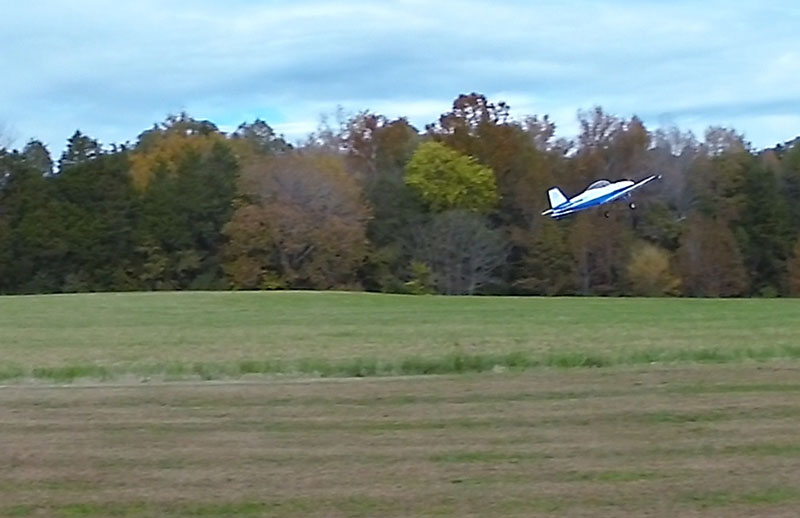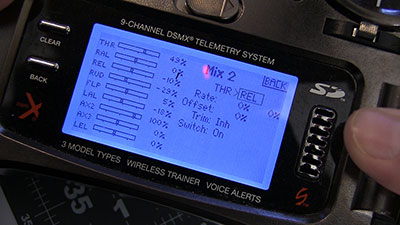



From the time it left the ground on the maiden the RV-4 wanted to balloon at speed.
Text, photos and video by Tom Hintz
Posted–11-26-2018
When my new Hangar 9 RV-4 left the ground for the first time everything was looking OK, but then as it accelerated it began to balloon, forcing me to apply a bunch of down elevator to control the climb rate.
This tendency to balloon at speed, along with a sensitive elevator at first had me thinking I had a CG issue. I ended the maiden flight early to move the batteries forward, but that process resulted in my first LiPo fire (See Fire in Resources below) that destroyed the fuselage. In the back of my mind I thought that if this ballooning had anything to do with an incidence error, the new fuse might cure it.
With my Hangar 9 RV-4 rebuilt, and the batteries moved forward to make it a bit more nose-heavy I again flew it and the ballooning at speed remained an issue. The elevator was less touchy, because of the CG change. The fact that the Hangar 9 RV-4 still wanted to balloon whenever I opened the throttle despite the CG change made me consider an engine thrust line problem but conversations with the folks at Horizon Hobby put all this in a different light. The Hangar 9 RV-4 was right, I was wrong. Alert the media.
One of the attractive features of the full-scale RV-4 is the super-wide speed envelope. It is capable of very stable low speed flight as well as remarkably high cruising speeds. That envelope comes in large part from the asymmetrical airfoil (wing shape) that generates a bunch of lift. I had already noted that the Hangar 9 RV-4 was a puppy at landing speeds but had not made the connection between airspeed and lift. That RV-4 airfoil that makes so much lift a low-speeds makes increasingly more lift as the airspeed goes up. Because the Hangar 9 RV-4 replicates the full-scale airfoil design, it also replicates the lift vs. speed phenomenon that was making my Hangar 9 RV-4 balloon when I went fast.
The wonder of modern radios gives us a few ways to manage this ballooning issue. Simply changing trims according to how you are flying works but requires constant updating whenever you change throttle settings for any amount of time. The good news is we can automate this in a couple ways. The “fixes” described here are specific to the Spektrum DX9 since that is what I use and have in the shop to demonstrate these programming techniques. I suspect these fixes can be accomplished with other radio brands, but I am not familiar with setting them up in those transmitters.
I frequently use F-Modes to create normal flight and landing configurations in my planes. When we enable F-Modes for specific channels, assigned to a multi-position switch, any trim changes we make are saved for the current switch position. My “normal” F-Mode has the elevator trimmed for fast flight and the throttle idle increased 200 to 300 rpm to reduce the chance of dead sticks when doing sudden throttle-off maneuvers like tumbles or tossing a plane around in the air. The “landing” F-Mode has my base idle speed and usually enough down elevator to help keep the nose down during landing approaches.

One way to control ballooning is to create a mix that
adds down elevator at higher throttle settings.
Of course, for F-Modes to work, you must remember the switch to which you assigned them. Since I use F-Modes on virtually all my planes and always assign them to the ”B” switch, using them has become second nature to me. If you do not already use F-Modes, the Hangar 9 RV-4 is a good plane on which to begin.
For more on programming Spektrum F-Modes see our “Using Spektrum F-Modes” in Resources below.
Another solution, suggested by the folks at Horizon Hobby, is to mix the elevator to the throttle. Using this transmitter feature we can have the elevator change the wing angle of attack in relation to the throttle stick position.
Setting this mix up turns out to be surprisingly simple. In the Mixing menu, choose an unused mix and enable throttle and then the elevator. The Hangar 9 RV-4 uses two elevator servos so I chose the right elevator channel. The Back Mixing built into the Spektrum DX9 mix programing automatically moves both elevator halves equally.
The first “rate” is where you control how much elevator change occurs when the throttle stick goes to maximum. On my Hangar 9 RV-4, positive values in this field produces down elevator, negative numbers produce up elevator. Go slow here, I started with 5% down elevator and slowly worked my way up to where my Hangar 9 RV-4 flew straight and level at full throttle.
The “Offset” field lets you move the elevator reaction within the throttle stick range of motion. If your Hangar 9 RV-4 starts “ballooning” at a lower throttle stick position you can move the onset of the elevator mixing to that point. Here again, make small changes until you are satisfied with how this mixing performs in your plane.
Finally, we can assign this mixing to a switch if you want to turn it on and off. I chose to assign this mix to a switch temporarily. I wanted to be sure I was not creating a mix that might make the Hangar 9 RV-4 hard to handle. Between the switch and making small changes at a time I had no issues.
After getting the lift/speed phenomenon handled, tuning the Hangar 9 RV-4 is simple. It takes some time, as it always does with a new plane, but the result is a nice handling, daily flier plane that fits virtually any RC flying field with ease.
The Hangar 9 RV-4 has a very large flight envelope so needing a little extra time to work out all the little “kinks” along the way is to be expected. In this case, I learned about mixing throttle and elevator, something that is both easy and can have far-reaching influences on future airframe tuning.
Many of the FlyingRC.net viewers contacting me about the Hangar 9 RV-4 are considering it as a gateway plane with which to get into flying giant scale. Certainly, its expansive flight envelope and superb handling are worth the learning curve to get it dialed in. There are many little things we must learn when making the jump to giant scale and the lessons learned with the Hangar 9 RV-4 will serve you well with future giant scale planes that may not be as forgiving nor as capable as the Hangar 9 RV-4. Sometimes learning about a new plane can be way more fun than we expect.
Hangar 9 RV-4 – The Build, From the box to ready for setup
FIRE! - I sabotage my own (new) RC airplane.
Have a comment on this Review? – Email Me!